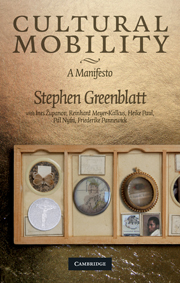Book contents
- Frontmatter
- Contents
- List of authors
- List of illustrations
- Acknowledgments
- 1 Cultural mobility: an introduction
- 2 “The Wheel of Torments”: mobility and redemption in Portuguese colonial India (sixteenth century)
- 3 Theatrical mobility
- 4 World literature beyond Goethe
- 5 Cultural mobility between Boston and Berlin: how Germans have read and reread narratives of American slavery
- 6 Struggling for mobility: migration, tourism, and cultural authority in contemporary China
- 7 Performativity and mobility: Middle Eastern traditions on the move
- 8 A mobility studies manifesto
- Index
- References
5 - Cultural mobility between Boston and Berlin: how Germans have read and reread narratives of American slavery
Published online by Cambridge University Press: 05 June 2012
- Frontmatter
- Contents
- List of authors
- List of illustrations
- Acknowledgments
- 1 Cultural mobility: an introduction
- 2 “The Wheel of Torments”: mobility and redemption in Portuguese colonial India (sixteenth century)
- 3 Theatrical mobility
- 4 World literature beyond Goethe
- 5 Cultural mobility between Boston and Berlin: how Germans have read and reread narratives of American slavery
- 6 Struggling for mobility: migration, tourism, and cultural authority in contemporary China
- 7 Performativity and mobility: Middle Eastern traditions on the move
- 8 A mobility studies manifesto
- Index
- References
Summary
On June 5, 2008 the German left-leaning daily Die Tageszeitung published in Berlin ran a cover story with an image of the White House and the headline “Uncle Barack's Cabin” written across it (figure 3). The caption added: “The White House in Washington: Will Barack Obama be the first black president to move in there?” The headline with its allusion to “Uncle Tom,” the protagonist of Harriet Beecher Stowe's mid-nineteenth-century sentimental reform novel, caused some controversy, nationally as well as internationally. Many journalists and political commentators considered the reference to the stereotype and racial slur of “Uncle Tom” to be entirely in bad taste, denigrating the presidential candidate of the Democratic Party and, by extension, all African Americans. Die Tageszeitung editor Rüdiger Metzger, however, defended the headline as a satirical comment: “Uncle Toms Cabin is a book that all Germans know and which they associate with issues of racism. The headline is supposed to make people think about these stereotypes … I'm sure 99 percent of our readers would understand it correctly. As for the rest, well, tough luck. You can't please everybody.” Local Afro-Germans and civil rights activists in Berlin took the headline as an opportunity to attack the “acute racism” in German left-wing circles, and the discussion of the headline spilled over from Berlin into the pages of the Washington Post as well as other forums and was hotly debated in internet blogs. American correspondents were astonished by this German piece of journalism.
- Type
- Chapter
- Information
- Cultural MobilityA Manifesto, pp. 122 - 171Publisher: Cambridge University PressPrint publication year: 2009



